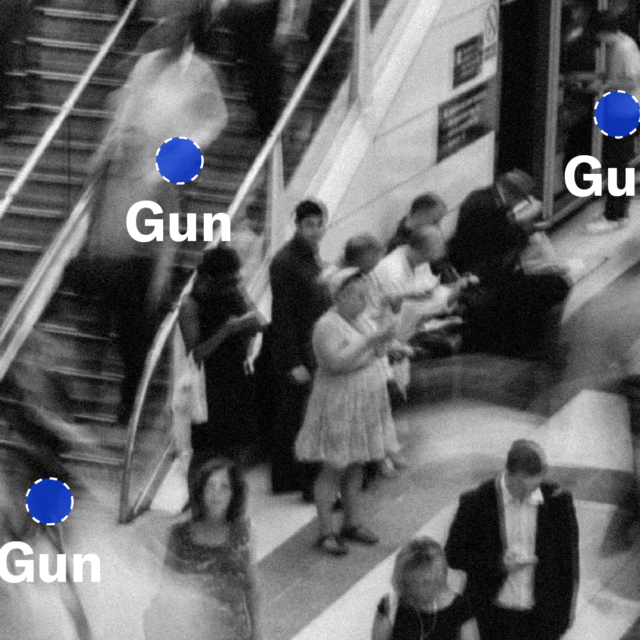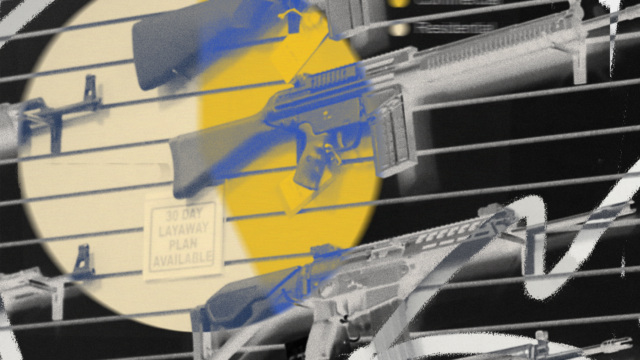
Executive Summary
Key Findings
- The US has nearly 78,000 licensed gun dealers, more than all post offices in the United States, and more than the number of McDonald’s, Burger King, Subway, and Wendy’s locations combined.
- Over half of all gun dealers are located in residential communities, including nearly 9,000 dealers licensed to manufacture firearms and ammunition, from handguns and shotguns to silencers and other accessories. Residential license holders, some in private homes, do not need to notify neighbors or place signage indicating that they can sell or manufacture guns in their homes.
- One in five public elementary schools is within half a mile of a gun dealer.
- A gun dealer license costs less than most liquor store or restaurant licenses.
- Just 2.5 percent of gun dealers sell over 50 percent of all guns in the United States.
- There are roughly five incidents per day where firearms go missing from gun dealers through robbery, burglary, larceny, or other loss. Too often these guns are diverted to the illegal market.
- While federal agencies recommend annual or more frequent inspections for elevators and restaurants, Federal Firearms License holders can expect to be inspected, at current rates, less than once per decade.
- States with the most gun dealers per capita have 10 times higher rates of guns trafficked to another state and subsequently used in a crime than states with the fewest gun dealers per capita.
- Find the licensed gun dealers in your neighborhood here.
What Is a Federal Firearms License?
Before engaging in the business of legally selling firearms in the United States, individuals and companies must apply for and receive a Federal Firearms License (FFL) from the ATF, the federal agency charged with regulating gun dealers. These licenses ensure that dealers meet certain minimum federal standards. In addition, they grant various permissions, ranging from selling and pawning firearms to importing or manufacturing firearms. Participants in all corners of the firearm industry—including defense contractors, antique firearms collectors, big-box chains, and individuals engaged in the business of selling firearms—must possess a license to conduct business legally.
There are over twice as many gun dealers as US post offices.

In 2022, there were nearly 78,000 active gun dealers.1Everytown Research analysis of ATF, Monthly Federal Firearms Listings, 2022. Total listings were deduplicated based on unique addresses. This is over twice as many gun dealers as US Postal Service post offices.2US Postal Service, “Postal Facts: Postal Service-managed Retail Offices,” accessed March 14, 2023, https://facts.usps.com/size-and-scope/. The total number of gun dealers has varied little over the past eight years, with just a 5 percent increase between 2015 and 2022.3There were 74,393 licensed dealers in 2015 and 77,813 in 2022. ATF, Monthly Federal Firearms Listings, 2015–2022.
Licensed gun dealers are located in cities, suburbs, and rural areas.
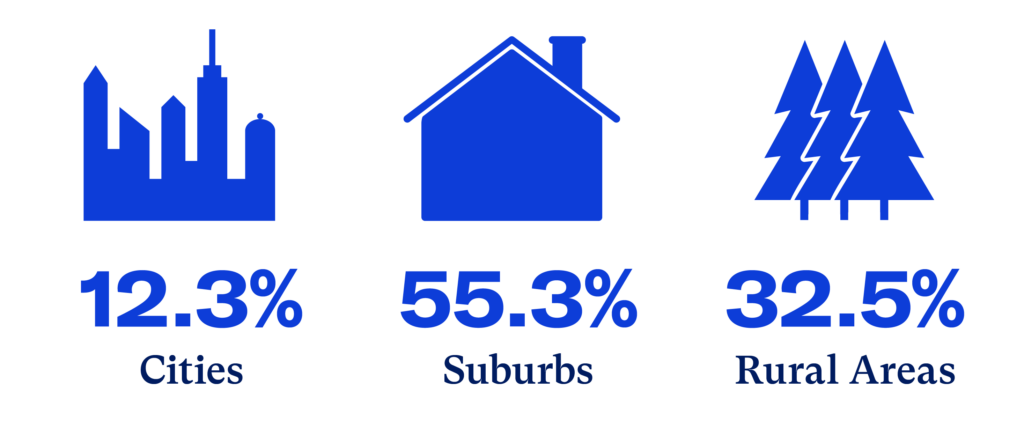
Licensed gun dealers are located in every state, in cities, suburbs, and rural areas alike.4Everytown Research analysis of ATF, Monthly Federal Firearms Listings, 2022, using the National Center for Health Statistics (NCHS) 2013 Urban-Rural Classification Scheme. The CDC designates six levels of urbanicity according to the NCHS 2013 Urban-Rural Classification Scheme: large central metro (cities); large fringe metro, medium metro, and small metro (suburban); and micropolitan and non-core (rural). Over half of licensees in the United States are located at residential addresses; the rest are in commercially zoned locations.5Everytown Research analysis of ATF, Monthly Federal Firearms Listings, 2022.
To obtain a license, individuals and companies must submit an application to the ATF. Applicants—and anyone else who will be responsible for administering the business—must provide personal information, fingerprints, and a photograph, in addition to undergoing a background check. Applicants must also submit a copy of the application to the chief law enforcement officer in their locality and have an in-person interview with an ATF agent. The fee ranges from $30 for collectors to $200 for most gun dealers.6ATF, “National Firearms Trafficking and Commerce Assessment (NFTCA), Volume I: Firearms in Commerce,” May 5, 2022, https://bit.ly/3LUCVM1. The interviewer then prepares a report, and the applicant is notified of approval or denial within roughly 60 days of initial submission.7ATF, “How to Become a Federal Firearms Licensee in 10 Easy Steps,” last reviewed April 6, 2020, https://bit.ly/3NYY36x.
Operating a store that sells lethal weapons is a weighty responsibility. Still, a gun dealer business license costs less than a license to operate a restaurant or liquor store. The table below shows licensing costs in Colorado, which has fees similar to many other states.
A firearms license costs less than a restaurant or liquor store license.
| Fee Type | Gun Dealer License, Type 1 or 28Some states have additional fees for gun dealers. For example, Georgia requires gun dealers to pay a $25 fee if they plan on selling handguns. Georgia Department of Public Safety, “Instructions for State Firearm Application” [DPS 442 (7/13)], https://bit.ly/3NZtyxA. Colorado does not require gun dealers to register with the state. | Small Retail Food Establishment, Colorado | Retail Liquor Store, Colorado |
|---|---|---|---|
| License Fee | $200 | $385 | $250-$350 |
| Renewal Fee (3-year-period) | $90 | $375-$6009Renewals for these licenses are required annually but dollar amounts are for renewals over a three-year period. The annual renewal is $125 for a restaurant with 1–25 seats and $200 for a restaurant with 26–100 seats. City of Denver, “Renewal Retail Food Establishment Application,” accessed March 29, 2023, https://bit.ly/3HV0vXN. | $682-$93710Renewals for these licenses are required annually but dollar amounts are for renewals over a three-year period. The annual renewal for a liquor store is $227.50 in a city and $312.50 in a county. Colorado Department of Revenue, Liquor Enforcement Division, “Colorado Beer and Wine License Renewal Application” [DR 8400 (03/31/23)], February 22, 2023, https://bit.ly/3Mg5Tr6. |
Not all federal firearms licenses are the same, since licenses cover many different parts of the commercial firearm industry. To account for this, the ATF created nine different license types. Each type grants different permissions to the license holder, ranging from the ability to sell guns to the ability to fabricate ammunition or destructive devices, such as bombs or grenades.8ATF, “Fact Sheet – Federal Firearms and Explosives Licenses by Types,” May 2019, https://bit.ly/3LRHHKf; ATF, “Firearms – Guides – Importation & Verification of Firearms – National Firearms Act Definitions – Destructive Device,” last reviewed April 26, 2018, https://bit.ly/3nRhfIS.
| ATF License Type | Description |
|---|---|
| Type 1 | Dealer in Firearms Other Than Destructive Devices |
| Type 2 | Pawnbroker in Firearms Other Than Destructive Devices |
| Type 3* | Collector of Curios and Relics |
| Type 6 | Manufacturer of Ammunition for Firearms Other Than Ammunition for Destructive Devices or Armor Piercing Ammunition |
| Type 7 | Manufacturer of Firearms Other Than Destructive Devices |
| Type 8 | Importer of Firearms Other Than Destructive Devices or Ammunition for Firearms Other Than Destructive Devices, or Ammunition Other Than Armor Piercing Ammunition |
| Type 9 | Dealer in Destructive Devices |
| Type 10 | Manufacturer of Destructive Devices, Ammunition for Destructive Devices or Armor Piercing Ammunition |
| Type 11 | Importer of Destructive Devices, Ammunition for Destructive Devices or Armor Piercing Ammunition |
* Type 3 licenses are not engaged in sales and thus are not included in the analysis in this report.
The three license types under which the most firearm sales are conducted are Types 1, 2, and 7. Dealers with these licenses account for 99 percent of commercial gun sales.9ATF, “NFTCA, Volume I: Firearms in Commerce.” Over 73 percent of gun dealers are licensed under Type 1 or Type 2 licenses, which allow individuals or companies to engage in selling and pawning firearms. Large chains like Walmart, Dick’s Sporting Goods, Bass Pro Shops, and Big 5 all hold Type 1 licenses. Pawn shop chains like Cash America and EZPawn hold Type 2 licenses.
Type 7 licenses permit gun dealers to manufacture, repair, and sell firearms. These licenses are the second most common license type and the fastest-growing segment of licenses, more than doubling from 7,671 in 2014 to 17,124 in 2022.10Everytown Research analysis of ATF, Monthly Federal Firearms Listings, 2014-2022. Major companies and individuals alike hold gun manufacturing licenses. Large gun manufacturers such as Sturm, Ruger & Company hold licenses that allow them to manufacture guns at nine locations across the country. Other large gun manufacturers like Palmetto State Armory and Aero Precision also hold multiple licenses to manufacture and distribute guns at scale. But in 2022, there were also nearly 4,000 Type 7 licenses linked to an individual’s name.
Dealers with Type 1, 2, and 7 licenses account for 99 percent of gun sales.
Despite the large number of gun dealers, the majority of gun sales come from a very small proportion of sellers. From 2017 to 2020, roughly 2.5 percent of gun dealers made over half of all commercial gun sales in the United States.11Everytown Research analysis of ATF, “NFTCA, Volume I: Firearms in Commerce.” Estimated minimum sales volume, 2017–2020, License types 1, 2, and 7.
Over half of gun sales come from under 3 percent of stores.
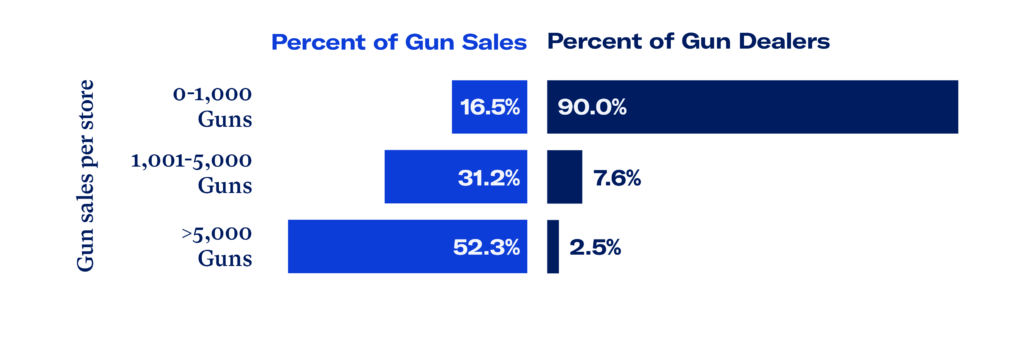
Home-Based Gun Dealers
When people picture a gun dealer, they typically think of a small to mid-sized store with guns lining the walls behind a counter. Or they may picture a sporting goods store with departments for fishing, hunting, and other outdoor activities. But most gun dealers in the United States do not look like this. Instead, most are licensed to residential addresses, and many of those locations are people’s homes.
What does a gun dealer look like?
Below are three images from Google Maps in Arizona. Which image is a licensed gun dealer?
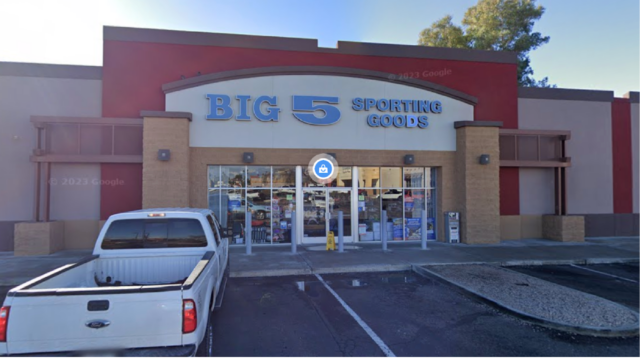
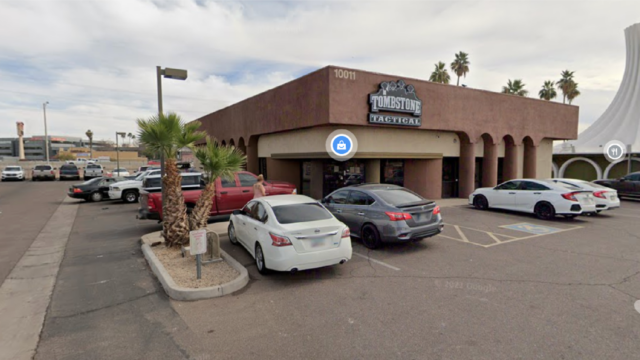
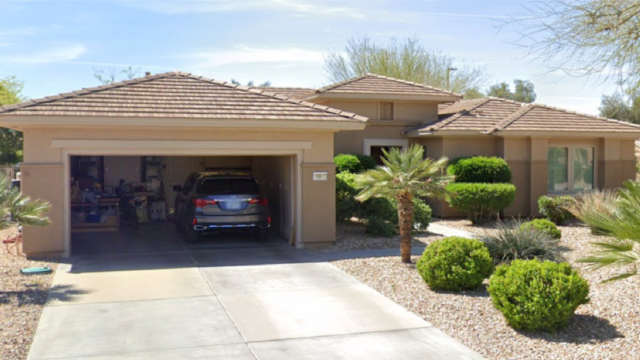
The correct answer is all three. Each of these locations is licensed by the federal government to sell firearms.
Our analysis of gun dealer address data revealed that in 2022, 57 percent of all licensed gun dealers were located at residential addresses.12The analysis in this report on residential vs. commercial addresses required a USPS Residential Delivery Indicator (RDI). We were able to match RDI with ATF-provided street addresses for all but 6,068 FFLs, or less than 8 percent. Fifty-seven percent of licensed addresses were in a residential location. This amounts to 40,831 FFLs in residential locations, 30,914 in commercial locations, and 6,068 unmatched FFLs. These home-based licensed dealers are found in every region of the country: over half of gun dealer locations in the Northeast, South, Midwest, and West are in residential areas. Even in large and medium cities, the majority of gun dealers are in residential zones.
Over half of gun dealers are in residential addresses.
Over 30,000 of these gun dealers were either Type 1 or Type 2, meaning that tens of thousands of locations where guns can be bought and sold in the United States are in individuals’ homes at so-called kitchen-table dealers. Beyond the ability to engage in the business of gun selling, possessing a home-based Type 1 or 2 license allows the dealer to buy guns directly from manufacturers (thus eliminating the middleman) and have guns shipped to their home. This benefit can extend to the license holder’s friends and acquaintances, since the license holder can purchase a gun from a manufacturer and sell it to their friends at cost, potentially avoiding transfer fees. It can also exempt individuals from many state-level laws, such as waiting periods and background-check requirements, since licensees can have guns shipped directly to their homes.
8,983
Nearly 9,000 locations licensed to manufacture firearms are in residential communities.
Everytown Research analysis of ATF, Monthly Federal Firearms Listings, 2022.
In addition, nearly 9,000 Type 7 licenses are linked to residential addresses. Possessing a Type 7 license allows dealers to manufacture weapons, including silencers and machine guns with the right paperwork, and to conduct all of the same sales and transfer actions as Type 1 license holders. In effect, this converts a home into a gun shop without requiring any notification or approval from neighbors.
Gun Dealers Near Schoolchildren
1 in 5
One in five public elementary schools is within a half mile of a gun dealer.
Everytown Research analysis of ATF, Monthly Federal Firearms Listings, 2022 and National Center for Education Statistics, Common Core of Data Public School Characteristics, 2020–2021.
The ATF requires FFL applicants to comply with local zoning ordinances.13Local ordinances can require applying to a city for a business license in a residential area or complying with local laws that dictate where firearm sales can occur. They vary enormously from city to rural area, residential to commercially zoned, and by license type. But these ordinances vary greatly across states, which means gun dealers can be found in surprising places. For instance, a considerable number of gun dealers are located near elementary schools: our analysis found that more than one in five public elementary schools is within half a mile of a licensed gun dealer.14Everytown Research analysis of ATF, Monthly Federal Firearms Listings, 2022 and National Center for Education Statistics, Common Core of Data Public School Characteristics, 2020–2021, https://bit.ly/3ptOtym. In total, 10,859 out of 53,022 public elementary schools are within half a mile of a gun dealer; of these, 52 percent are within half a mile of a commercially zoned dealer and 56 percent are within half a mile of a residentially zoned dealer.15Some schools are within half a mile of both residential and commercial gun dealers, resulting in a total of over 100 percent. In Mesa, Arizona, there are 10 gun dealers within half a mile of Sequoia Elementary School. The large number of gun dealers near schools is a concern because of the crime they attract. In 2021, there were nearly 900 thefts or robberies from gun shops, a rate of over two per day.16Everytown Research analysis of ATF, “Federal Firearms Licensee Theft/Loss Report, 2021,” January 18, 2022, https://bit.ly/43HQHsX.
Gun Dealer Concentration Varies by State
Cities and states across the country have vastly different numbers of gun dealers per resident. While the United States average is 24.5 gun dealers for every 100,000 people, Wyoming has more than one gun dealer for every 100 people. At the other end of the spectrum, Massachusetts has fewer than one gun dealer per 10,000 people.17Everytown Research analysis of ATF, Monthly Federal Firearms Listings, 2022, and US Census, American Community Survey 1-Year Population Estimates, 2022. The location of gun shops is, of course, partly in response to the demand for guns. Thus, gun ownership in these states follows the same pattern: 66 percent of adults in Wyoming live in a household with a gun, while just 15 percent of adults in Massachusetts do.18Terry L. Schell et al., “State-Level Estimates of Household Firearm Ownership,” RAND Corporation, April 22, 2020, https://bit.ly/3VR9WNQ.
Gun Dealer Concentration by State
| State | Gun dealers per 100,000 residents, 2022 |
|---|---|
| United States | 24.5 |
| Wyoming | 132.8 |
| Montana | 115.7 |
| Alaska | 89.4 |
| South Dakota | 71.7 |
| Idaho | 71.3 |
| North Dakota | 70.9 |
| Vermont | 60.9 |
| West Virginia | 57.6 |
| Arkansas | 51.0 |
| Iowa | 47.6 |
| Oklahoma | 45.6 |
| Kansas | 45.5 |
| Maine | 45.4 |
| New Hampshire | 44.5 |
| Utah | 42.6 |
| Nebraska | 42.4 |
| Missouri | 41.8 |
| Colorado | 39.7 |
| Mississippi | 37.9 |
| Arizona | 37.4 |
| Oregon | 37.0 |
| Kentucky | 36.6 |
| New Mexico | 36.5 |
| Wisconsin | 30.8 |
| Louisiana | 30.3 |
| Texas | 29.9 |
| Alabama | 29.8 |
| Minnesota | 29.6 |
| North Carolina | 29.0 |
| South Carolina | 28.4 |
| Tennessee | 27.7 |
| Nevada | 27.0 |
| Indiana | 25.8 |
| Ohio | 25.6 |
| Pennsylvania | 25.4 |
| Michigan | 25.4 |
| Virginia | 25.3 |
| Georgia | 23.8 |
| Florida | 20.3 |
| Washington | 19.8 |
| Connecticut | 18.6 |
| Delaware | 15.4 |
| Illinois | 13.2 |
| Maryland | 12.6 |
| New York | 11.0 |
| Rhode Island | 9.9 |
| Massachusetts | 9.1 |
| Hawaii | 7.6 |
| California | 6.8 |
| New Jersey | 4.0 |
| District of Columbia | 0.9 |
Where Are the Licensed Gun Dealers in Your Neighborhood?
Gun dealer location data as of January 2022.
The Connection Between Gun Dealers and Gun Trafficking
Federal law prohibits licensed dealers from selling firearms to individuals prohibited from possessing them for any reason, including failing a background check, being underage, having a court restraining order, and more. But gun trafficking, where guns move from legal to illegal markets, circumvents these protections.
In 2021, over 10,300 guns were either lost by or stolen from gun shops. This amounts to a rate of 28 guns per day likely moving from legal to illegal markets where they can be trafficked to be used in crimes.19Everytown Research analysis of ATF, “Federal Firearms Licensee Theft/Loss Report, 2021.” In addition, many trafficked guns are initially bought by a “straw purchaser”—someone who procures a firearm for someone other than themself. Straw purchasers frequently buy guns for people who are prohibited from owning a gun or who do not want to be associated with the gun’s purchase, often because they intend to use the gun in a crime. A survey of federally licensed firearms dealers estimated that there are between 28,500 and 43,600 attempted straw purchases each year,20Garen J. Wintemute, “Frequency of and Response to Illegal Activity Related to Commerce in Firearms: Findings from the Firearms Licensee Survey,” Injury Prevention 19, no. 6 (2013): 412–20, https://doi.org/10.1136/injuryprev-2012-040715. and in February 2024 the ATF disclosed that 1,300 gun dealers sold a high volume of crime guns recovered by law enforcement in the previous year.21This list includes FFLs that had 25 or more firearms traced to them the previous calendar year with a “time-to-crime” of three years or less.
Gun traffickers take advantage of state-level differences in both laws and gun access to bring guns from states with fewer gun safety laws and more gun shops to those with more gun safety laws and fewer gun shops. For example, 12 percent of guns recovered from crimes in New York, a state with strong gun laws and among the fewest licensed dealers per capita, were purchased in Georgia. However, in Georgia, gun safety laws are among the weakest in the nation, and there are twice as many gun dealers per capita than in New York.
More crime guns are trafficked from states with more gun dealers per capita to states with fewer gun dealers per capita.
| Fewest Gun Dealers → Most Gun Dealers | ||||
|---|---|---|---|---|
| Quartile 1 | Quartile 2 | Quartile 3 | Quartile 4 | |
| Licensed gun dealers per 100,000 people | 9.7 | 24.9 | 35.6 | 57.6 |
| Guns trafficked to other states per 100,000 people | 1.7 | 15.7 | 20.5 | 17.1 |
| Guns trafficked from other states per 100,000 people | 148.0 | 149.0 | 107.9 | 74.1 |
What is the definition of a trafficked gun?
Two key elements determine whether a gun was trafficked. The first is “time-to-crime,” or the length of time between when someone purchased the gun and when it was used in a crime. The shorter the time-to-crime, the more likely it is that the gun was purchased with the intent of being used in a crime. The ATF classifies guns that were recovered within three years of their purchase as guns that were likely purchased with the intent to use in a crime.1ATF, “National Firearms Commerce and Trafficking Assessment (NFTCA), Volume II: Crime Gun Intelligence and Analysis—Part III: Crime Guns Recovered and Traced within the United States and Its Territories,” January 2023, https://www.atf.gov/file/175291/download. The second factor in identifying trafficked guns is whether or not a gun crossed state lines. Guns that are recovered by law enforcement after moving across state lines were likely brought from the purchase state with the intent of being sold illegally or used in a crime.
States with the highest number of gun dealers per capita have 10 times higher rates of guns trafficked to another state and subsequently used in a crime than states with the fewest number of gun dealers per capita.22Everytown Research analysis of ATF, Monthly Federal Firearms Listings, 2021 and ATF, Firearms Trace Data, 2017-2021. In fact, gun traffickers often take these guns to states with fewer gun dealers: states with the fewest FFLs per capita receive over twice as many trafficked guns per capita compared to states with the most FFLs per capita.
States with the most gun dealers per capita also tend to recover crime guns closer to their purchase location. Nearly 40 percent of crime guns recovered in states with the most gun dealers per capita were bought at a dealer less than 10 miles from the crime. Less than 20 percent of crime guns in those states could be traced to gun shops over 300 miles away. On the other hand, nearly 36 percent of crime guns in states with the fewest gun dealers per capita were purchased over 300 miles from where the crime occurred.23Everytown Research analysis of ATF, “NFTCA, Volume II: Crime Gun Intelligence and Analysis—State Reference Tables,” January 2023, https://bit.ly/3poAhXk.
10x
States with the highest number of gun dealers per capita have 10 times higher rates of guns trafficked to another state and subsequently used in a crime.
Everytown Research analysis of ATF, Monthly Federal Firearms Listings, 2021 and ATF, Firearms Trace Data, 2017-2021.
40%
Nearly 40 percent of crime guns recovered in states with the most gun dealers per capita were bought at a dealer less than ten miles from the crime.
Everytown Research analysis of ATF, “NFTCA, Volume II: Crime Gun Intelligence and Analysis—State Reference Tables.”
The same relationship holds true at the city level. Everytown analyzed the full set of ATF city gun trafficking reports, dividing the 40 cities into four groups based on how many gun dealers per capita their states had.24ATF, “NFTCA, Volume II: Crime Gun Intelligence and Analysis—State Reference Tables.” The ATF selected 10 cities from each of the following four population size categories: mega cities (one million or greater residents), large cities (500,000 to 999,999 residents), medium cities (250,000 to 499,999 residents), and small cities (100,000 to 249,999 residents). On average, cities in states with the fewest gun shops per capita traced over 40 percent of their crime guns to dealers located over 300 miles away. Conversely, cities in states with the most gun dealers per capita could trace over half their crime guns to dealers less than 10 miles from where the crime occurred.25Everytown Research analysis of ATF, “NFTCA, Volume II: Crime Gun Intelligence and Analysis—City Reference Tables,” January 2023, https://bit.ly/3poAhXk. The 40 cities in this analysis are found in 24 states. The quartiles here are calculated using data in these 24 states.
These analyses connect the number of gun dealers per person in a state to the prevalence of crime guns coming from that state. The more gun dealers a state has, the more likely that state is to be a source of crime guns both for itself and for other states around the country.
Read More About Gun Trafficking
-
Case Study: Westforth Sports, Inc.
Westforth Sports, Inc., is a licensed gun dealer in Gary, Indiana, approximately 30 miles from the City of Chicago in neighboring Illinois. From 2009 to 2016, the latest year data is available, Westforth Sports was ranked the largest out-of-state supplier of firearms recovered by Chicago police in connection with crimes.1City of Chicago v. Westforth Sports, Case No. 2021CH01987 (Cook Cnty. Cir. Ct.), Complaint, p. 1. As a recent lawsuit by the city of Chicago highlights, this is due largely to Westforth’s practice of selling guns to straw purchasers. Chicago’s lawsuit alleges that Westforth contributed to interstate trafficking in a number of ways:
- Allowing purchasers to change answers on purchase forms2City of Chicago v. Westforth Sports, Case No. 2021CH01987 (Cook Cnty. Cir. Ct.), Chicago’s Opp’n to Deft.’s Sect. 2-619 Mot. to Dismiss for Lack of Pers. Jurisd., pp. 8–9.Westforth encouraged buyers to change answers on their purchasing form to mask potential flags about trafficking. Examples described in public court filings include Westforth telling customers to “correct” answers about whether they were the actual buyer of the gun or their state of residence to allow Westforth to complete the sale.
- High-volume sales of identical and near-identical guns3Id., pp. 9–11.Buying multiple guns of the same make and model within a short time period is a strong indicator of gun trafficking. Public filings describe numerous instances of this type of purchasing at Westforth, such as one buyer who bought 20 guns, including some in four- and five-of-a-kind, and another who bought 15 guns, including four near-identical handguns, in a single transaction. Many of these guns were later recovered in others’ possession by Chicago police, including several just days after purchase. Yet, even after these recoveries, Westforth continued to sell firearms to individuals who they should have reasonably believed would illegally traffic them. From 2014 to 2021, Westforth sold guns to 53 individuals who were later charged with purchasing their guns illegally. While this example is particularly egregious, it underscores the pivotal role FFLs play in the life cycle of crime guns.
- Inadequate procedures to detect and prevent straw purchases4Id., pp. 13–14.Public filings document serious deficiencies in Westforth’s policies and procedures to detect and report suspicious transactions. ATF has repeatedly cited the store for failing to timely report multiple handgun sales—a deficiency that keeps law enforcement in the dark about this potential indicator of straw purchasing. And despite ATF recommending that the store retain records of denied sales in order to help identify potential straw purchasers, inspectors later found that Westforth was instead destroying these records. Store employees also testified that the store has no formal procedures to identify or flag customers who structure bulk purchases to avoid multiple sale reporting requirements, or who try to buy a gun after one of their previous purchases has been recovered and traced by law enforcement.
States with weaker gun safety laws have more gun dealers per capita.
Everytown tracks the gun laws in all 50 states and has scored them on a set of 50 key gun safety policies. Examining the association between these scores and rates of gun violence, Everytown found a strong relationship between gun laws and gun deaths:26r = –.63, p < .000. states with stronger gun safety laws have lower rates of gun deaths. As gun law strength increases in a state, gun deaths go down. Connecting this analysis to gun dealers, Everytown found that states with weaker gun laws also have more gun dealers per capita than states with stronger laws.
| Gun Law Ranking Category | Gun Dealers per 100,000 Residents |
|---|---|
| National Leaders (CA, NY, HI, NJ, CT, MA, IL, MD) | 10.4 |
| Making Progress (OR, WA, DE, CO, RI, VA, PA, NM, MN, NV) | 26.6 |
| Missing Key Laws (FL, VT, NC, NE, WI, MI, ME, LA, WV) | 40.2 |
| Weak Systems (SC, TN, IN, IA, TX, OH, AL, ND, UT) | 36.5 |
| National Failures (KS, MO, NH, KY, AK, AZ, OK, WY, SD, MT, GA, ID, AR, MS) | 60.4 |
See Our State Gun Law Rankings
Are Gun Dealers Adequately Regulated?
The ATF is the federal agency responsible for regulating and conducting inspections of licensed gun dealers. These inspections determine whether sellers are complying with federal laws designed to prevent criminal access to firearms.
The least-severe violations resulting from inspections can result in a report, letter, or warning conference with the licensee.27ATF, “Firearms Compliance Inspections,” last reviewed August 3, 2021, https://bit.ly/3HZCPSj. Violations that result in license revocation by the ATF include such issues as willfully transferring a firearm to a prohibited person, failing to conduct a required background check, falsifying records, failing to respond to a crime gun trace request, or preventing the ATF from completing an inspection. The most common violations are failure to maintain accurate records of firearm purchases and sales, failure to complete ATF forms as prescribed, and failure to record National Instant Criminal Background Check System (NICS) contact information, which may impede law enforcement investigations.28ATF, “Firearms Compliance Inspections.”
The ATF aims to inspect each licensed dealer every three years, but in 2023, it only inspected about 9,050 dealers, or 11 percent of FFLs, leaving the agency well short of its stated goal.29The ATF is generally prohibited by law from inspecting a firearms business more than once every 12 months unless it obtains a warrant. 18 U.S.C. § 923; 27 CFR § 478.23, 479.22; ATF, “Federal Firearms Licensee Quick Reference and Best Practices Guide,” December 2021, https://bit.ly/3I0Hx2l; ATF, “Fiscal Year 2023: Congressional Budget Submission,” March 2022, https://bit.ly/42hGuTD; ATF, Monthly Firearms Compliance Inspection Results, 2022. At this rate, a gun dealer could expect to be inspected once every 9 years, and in some cases, gun dealers have not been inspected for longer.30Assuming inspection levels remain the same, 9,050 inspections in 2023 with over 81,000 active gun dealers yields an estimate of one inspection every 9 years. Everytown Research analysis of Bureau of Alcohol, Tobacco, Firearms, and Explosives Firearms Compliance Inspection Results, 2023, May 2024, https://bit.ly/3JQ1qcX. Federal regulators of elevators and restaurants require inspections 5 to 10 times more frequently: the US Department of Labor requires inspection for elevators annually;31OSHA Standard No. 1917.116, https://bit.ly/3NZBFtF. the FDA Food Code recommends restaurants generally be inspected at least once every six months.32FDA Food Code 2022 § 8–401.10, https://bit.ly/3VQ6sv3.
ATF data reveals that, when they occur, dealer inspections generally yield a large number of violations. In fiscal year 2020, ATF inspectors found violations in just under half of inspections.33ATF, “Firearms Compliance Inspection Results FY 2020,” last reviewed May 9, 2023, https://bit.ly/3VWJtP8. In addition, inspectors frequently found multiple violations, issuing over two million citations over the period 2016 through 2020.34ATF, “NFTCA, Volume I: Firearms in Commerce.” In 2023, the ATF revoked 157 licenses, and an additional 80 dealers ceased operations after inspections revealed violations that could result in license revocation.35ATF, “Enhanced Regulatory Enforcement Policy,” last reviewed May 8, 2024, https://bit.ly/44Jat8J. Revocations are inconsistent, though, and a recent inspector general report found multiple instances of ATF inspectors who did not revoke licenses from dealers with multiple revocable offenses.36US Department of Justice, Office of the Inspector General, “Audit of the ATF’s Risk-Based Inspection Selection Processes.”
In sum, the frequency of violations and the rarity of inspections allow the possibility that thousands of dealers are violating federal gun regulations each year without any corrective action by the ATF. And the lack of inspections of scofflaw dealers may explain the correlation between the number of gun dealers in a state and the likelihood that guns will be trafficked from that state.
What Are Effective Policy Solutions?
The laws that govern how licensed gun dealers conduct their business have not been updated since the 1960s and do not provide strong oversight today. Higher safety standards for gun dealers could reduce rates of gun violence across the country by helping to hold bad dealers accountable for actions that contribute to gun crimes and stop the stream of illegal guns into communities. Key legislative measures at the federal, state, and local levels have the potential to bridge these gaps.
Federal Recommendations
Congress can update and modernize standards for licensed gun dealers and provide ATF and law enforcement with better tools to identify dealers who fail to meet those standards by passing the Federal Firearm Licensee Act (FFLA).37H.R. 1478, 118th Cong. (1st Sess. 2023). Key policy changes proposed in the FFLA include:
- Increasing the frequency of ATF inspections to require annual inspections for dealers most connected to crime guns and inspections every five years for all others.
- Requiring third parties such as gun shows and websites to run background checks on all firearm sales and inform the ATF of any sales before a background check has been completed.38Under federal law, gun purchases may move forward by default after three business days—even if a background check has not been completed.
- Closing the indicted dealer loophole, so that gun dealers under indictment cannot buy or sell firearms.
- Doubling the cost of an FFL. Gun industry profits have soared, with gun companies netting approximately $3 billion since the pandemic began,39Champe Barton, “Shootings Have Surged—and Gun Companies Have Made Billions,” The Trace, May 27, 2022, https://bit.ly/3Bc5EqZ. yet licensing fees for gun dealers have not increased since 1993.40H.R. 1025, 103rd Cong. (1993); Keith Bea and James Sayler, “Brady Handgun Violence Prevention Act,” Congressional Research Service, August 5, 1997, https://bit.ly/40msLtN.
- Requiring increased security measures such as video surveillance, modernized record systems, and employee background checks to protect against inventory losses, thefts, and straw purchases.
- Requiring dealers to retain records beyond the current 20-year threshold, as well as establishing an electronic database of all firearm records in the ATF’s possession to streamline crime-gun-tracing efforts.
In addition, the ATF should use the authority that Congress has already provided to conduct rigorous oversight of gun dealers and to hold dealers in violation of existing laws and regulations accountable. That includes:
- Conducting more gun dealer inspections while prioritizing rogue dealers and exercising license revocation power.
- Modernizing record-keeping, including sustained support for National Tracing Center efforts to process paper out-of-business records, and data analysis capabilities.
- Enforcing new anti-gun trafficking and anti-straw purchasing criminal statutes enacted in the Bipartisan Safer Communities Act.
- Sharing information with state and local law enforcement partners on crime gun sources and firearm trafficking patterns.
For the ATF to be effective, it must be fully funded and supported by Congress. Full funding and strong support are mission-critical, and will enable the ATF to build capacity and leverage resources to implement and enforce our gun violence prevention laws and regulations.
State Recommendations
State legislatures can also help close regulatory gaps by independently licensing firearm dealers, as is currently in place in several states, including Hawaii and Pennsylvania. These states allow unlimited inspections of gun dealers by in-state authorities.41HRS § 134-32(4); 37 Pa. Code § 33.116(c). Licensing schemes should include requirements for state and local inspections, secure premises, employee background checks and training, and public nuisance statutes.
States can also require regular transaction reporting to state and/or local law enforcement to expedite crime gun tracing. Maryland has also found success in implementing security requirements including video surveillance, monitored alarm systems, physical barriers, and secure storage of firearms when gun dealerships are closed.422022 Md. HB 1021; Md. Public Safety Code Ann. § 5-145.1(a)(2) [effective October 1, 2022]. Employee screening and training requirements too can ensure that staff are not prohibited from possessing firearms themselves and that they are well-equipped to educate customers on firearm safety and legal obligations. Along these lines, Virginia currently requires prospective employees to pass criminal background checks.
Finally, nuisance statutes such as those in California, Delaware, New Jersey, and New York, enable lawsuits against gun dealers who knowingly violate state gun sales and marketing laws.4315 U.S.C. §§ 7901–7903. Collectively, these requirements can help ensure compliance with applicable state laws and prevent theft, burglary, straw purchases, and trafficking from licensed gun dealers.
Local Recommendations
Local law enforcement offices can contribute to safer licensed gun dealership practices primarily through publishing gun-tracing reports and prosecuting rogue dealers. Local gun-tracing reports should feature data on the number and locations of recovered firearms plus the dealer and state they originated from. This data is vital for both identifying patterns of negligence and capturing the impact of local efforts made to address these problems. It could also help local law enforcement agencies decide where to purchase their own guns and ammunition from.
Once a pattern of negligent behavior is established, local and state officials should prosecute rogue gun sellers. In one example, the Minnesota attorney general filed a civil lawsuit against a large retailer with several FFLs for negligently selling dozens of firearms that were later involved in crimes around the Twin Cities,44Dana Ferguson, “Minnesota Sues Fleet Farm Over ‘Dangerous’ Firearm Sales,” MPRNews, October 5, 2022, https://bit.ly/3OhuM7x. claiming the retailer ignored obvious signs of straw purchasing and requests. When paired together, these local efforts contribute to vital accountability among licensed gun dealers.
Conclusion
Nearly every gun in the United States begins as a legal gun, purchased by a consumer from a licensed gun dealer. While much research follows what happens to a gun after it has been purchased, this report looks upstream. It focuses on the places these guns are sold, the role the ATF plays in making sure these guns get into and stay in the hands of legal owners, and the actions necessary to stem the tide of gun violence in our country and build safer communities.
Acknowledgments
Everytown for Gun Safety Support Fund would like to gratefully acknowledge Dr. Daniel Semenza, director of interpersonal violence research from the New Jersey Gun Violence Research Center at Rutgers University, and Dr. David Johnson, assistant professor of economics at the University of Central Missouri, for sharing their expertise during the development and drafting of this report.
Learn More:
Everytown Research & Policy is a program of Everytown for Gun Safety Support Fund, an independent, non-partisan organization dedicated to understanding and reducing gun violence. Everytown Research & Policy works to do so by conducting methodologically rigorous research, supporting evidence-based policies, and communicating this knowledge to the American public.


